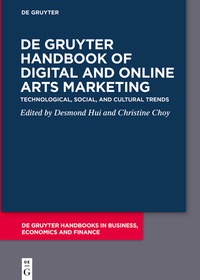
De Gruyter Handbook of Digital and Online Arts Marketing
Technological, Social, and Cultural Trends
Series: De Gruyter Handbooks in Business, Economics and Finance;
- Publisher's listprice EUR 139.95
-
58 044 Ft (55 280 Ft + 5% VAT)
The price is estimated because at the time of ordering we do not know what conversion rates will apply to HUF / product currency when the book arrives. In case HUF is weaker, the price increases slightly, in case HUF is stronger, the price goes lower slightly.
- Discount 5% (cc. 2 902 Ft off)
- Discounted price 55 142 Ft (52 516 Ft + 5% VAT)
Subcribe now and take benefit of a favourable price.
Subscribe
58 044 Ft

Availability
Not yet published.
Why don't you give exact delivery time?
Delivery time is estimated on our previous experiences. We give estimations only, because we order from outside Hungary, and the delivery time mainly depends on how quickly the publisher supplies the book. Faster or slower deliveries both happen, but we do our best to supply as quickly as possible.
Product details:
- Edition number 1
- Publisher De Gruyter
- Date of Publication 14 December 2025
- ISBN 9783110754612
- Binding Hardback
- No. of pages450 pages
- Size 240x170 mm
- Language English
- Illustrations 23 Illustrations, black & white; 4 Tables, black & white 700
Categories
Long description:
Having an online and digital presence has today become essential for art organizations, artists, and artworks. In the maturing field of arts marketing, there has been an ongoing academic debate in the last decade about the nature and value of two competing approaches: whether an organization-centered or a consumer-centered approach shows a higher relative effectiveness in enhancing the performance criteria of arts organizations (Boorsma, 2006). Shifting the focus from a business orientation, digital and online arts marketing provides an additional promising perspective on the debate (Choi & Burnes, 2013). The current trend of marketing the arts via virtual platform networks more effectively engages international audiences to participate in a co-creation process (Edvardsson, Tronvoll, & Gruber, 2011;), connecting them to the various fields of the arts and sustaining a long-term relational and humanistic network of communities in art appreciation (Thyne & Hede, 2016; Walmsley, 2019).
From an organization-centered approach, arts marketing serves as functional tool of an art organization and as a business strategy and mindset. This line of research focuses primarily on how marketing practices facilitate the pursuit of organizational goals and interests in terms of tangible outcomes (such as profits for profit-making arts companies, sponsors, volunteers and donations for non-profit arts organizations) and intangible outcomes (such as the reputation of the organization, or the quality of its stakeholder relationships).
A consumer-centered approach addresses these limitations by systematically analyzing and prioritizing consumer needs and desires, perceptions and preferences, and the degree of satisfaction in the marketing of the arts. This approach assumes that adapting arts products or services through the creation of consumer value can increase sales levels through greater consumer satisfaction. However, studies have pointed out that such a business mindset may lead to pitfalls in arts marketing because the creation of consumer-centered arts may hinder the creativity of artists, violate the principles of artistic expression, over-commercialize the field of arts and lower artistic and cultural value.
For this Handbook, we consider digital and online arts marketing as a timely and evolving trend that is constantly pushing the boundaries of the existing paradigms to explore new possibilities to achieve a balance between artistic and consumer values. Through a multidisciplinary and co-creation approach, the rise of new media and digital technologies has facilitated digital arts marketing to take the lead (O’Reilly, 2011; Özdemir, Fillis, & Collins, 2020); a trend that has been accelerated by the Covid-19 pandemic and the new normal that has transformed the practices of a mixed-mode of cultural and creative production, distribution, and consumption. In view of rapid social, cultural, and economic changes and the fluid and uncertain contemporary art market, many organizations have begun to reflect on putting aside organization- or consumer- centered approaches and instead turned to the possibility of adopting the logic of mediatization (Have & Pedersen, 2013; Jasson, 2002; Krämer, 2011; Wilke, 2014), creating a mixed-mode of arts collaboration, co-operation, and co-creation of arts marketing (Baumgarth, 2018).
More



